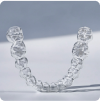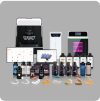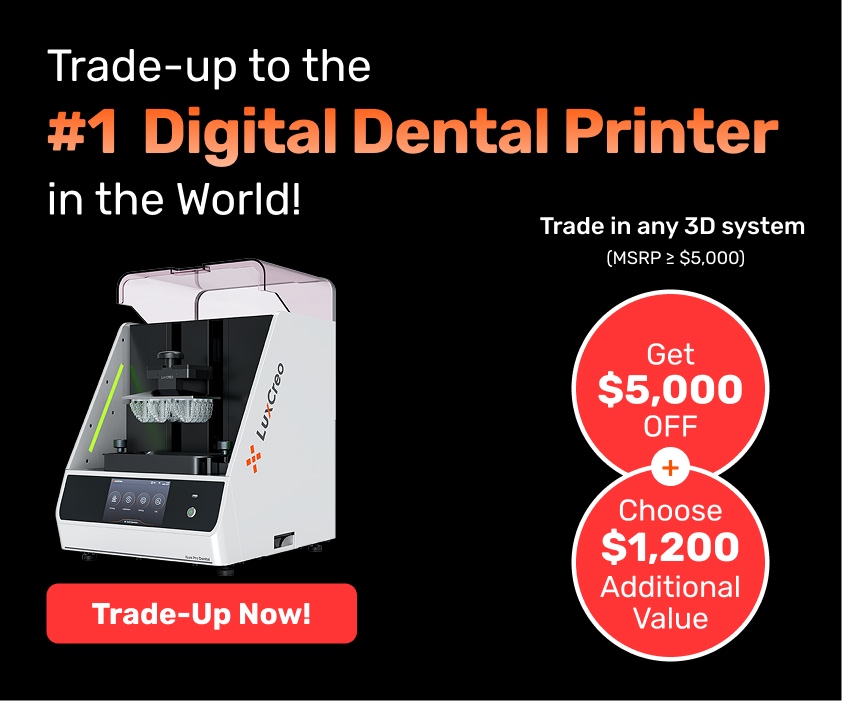
3D Printing in Dentistry: Outsourcing, Bringing In-house, or Both?
3D printing technology is transforming the dental industry for providers and patients. Both dentists and orthodontists have been leveraging 3D printers to create durable, customized appliances with increased frequency year after year. Studies show that between 2017 to 2023, the dental 3D printing market will be growing at a CAGR of 23.2 %, beginning the forecasted period at $1.39 billion market value and ending at $5.06 billion. Related projections foresee 500 million dental devices/restorations being 3D-printed annually by 2022.
Advancements in printers and resins have accelerated the adoption of 3D printing in dentistry. 3D printers now operate quicker and more cost-effectively than traditional dental appliance production methods. Dentists and orthodontists that implement 3D printers into their practices can improve their workflows, grow their practice, and create a better patient experience.

Outsourcing Model
Dental and orthodontic practices use lab services to create oral appliances, restorations, and aligners.
In the outsourcing model, the practitioner takes oral impressions of the patient’s mouth using a conventional impression model or digital intraoral scans and sends the impressions to a lab. Techs at the lab fabricate the device and mail it back to the practice. Turnaround time varies depending on shipping, the appliance type, and whether the impression is physical or digital. Generally, making dental devices from physical models will have a two to four-week turnaround, while leveraging the digital model will take one to two weeks. After the dental office receives the device, the practitioner finalizes the process by scheduling a follow-up appointment with the patient to ensure that the oral device fits and operates correctly.
Traditionally, dentists and orthodontists use the outsourcing model to avoid purchasing expensive equipment and performing the labor associated with producing oral devices. For instance, a physical dental model’s creation requires specialized tools and days of intensive hands-on work. The software and hardware used to make digital dental appliances were historically inaccessible to dental practitioners, as they cost around $200,000 in the early 2000s. Consequently, only the largest dental labs could afford the tools necessary for complete digital workflows.
In recent years, technology advancements have lowered the cost of 3D printers and expanded their capabilities. The availability of 3D printers has improved the outsourcing model. Dental practices can now send orders to local 3D printer-filled smart factories and 3D printing-enabled dental labs, improving the device turnaround time.
Hybrid Model
The use of 3D printing in dentistry has existed since the late 1990s, but the early machines’ cost and limited availability of appropriate materials prohibited widespread use. If practices wanted to access the technology to make clear aligners or dental molds, they had to contract their services. Modern desktop 3D printers are far more accessible to dental practices. They do not carry the steep price tag that older models did, but they retain or even exceed many of the same capabilities. 3D printers can produce a variety of oral devices:
- Night guards and retainers
- Clear aligners
- Dental models
- Surgical Guides
- Crowns and Bridges
- Dentures
Practices that integrate a 3D printing solution into their operation gain control of their workflows and reduce production turnaround time from weeks to hours. In some instances, reducing production time also eliminates patients’ need to make multiple appointments to obtain an oral device.
When a patient requires a night guard or retainer, the dentist can perform an intraoral scan at the beginning of the appointment to start the creation process. The patient can then receive a routine cleaning as the night guard forms. By the end of the appointment, the patient can have their new night guard in hand.
In the hybrid model, dentists and orthodontists use a desktop 3D printer for same-day services. For more time-consuming applications (e.g., entire clear aligner sets) or demand spikes, the practice can reach out to a dental lab or 3D printer-filled smart factory to meet their needs.
Offices wanting to adopt the hybrid model gain full control over their 3D printing operation can invest in high-performance desktop printers for in-house production and maintain production flexibility by outsourcing excess demand to 3D printing dental labs.
Completely In-House Model
High-performance 3D printers enable dental professionals to create oral devices in-house, saving money on lab fees/shipping costs, deliver devices same-day to patients, and have reduced or no post-processing steps. Older 3D printing processes required a highly skilled technician to operate the hardware. Newer systems still require an operator but are much easier to bring in-house.
3D printers have been used since the nineties to create some oral appliances, but specific applications required post-processing steps that are both time-consuming and labor-intensive. For example, some systems can create retainers in an hour but require post-processing that involves a combination of washing, curing, and buffing. Practices and dental labs often choose to avoid the extra post-processing steps by thermoforming aligners instead.
New developments in 3D printing are achieving faster printing time and eliminating many post-processing steps. Dental solutions like LuxaDent use resins that print clear. After printing and curing a clear aligner, the technician simply buffs down the contact points, and the device is ready for use. Clear printing methods and materials can produce retainers, night guards, and surgical guides in a fraction of the time of older 3D printers, allowing practices with in-house machines to serve patients at a quicker pace than ever before.
Discover the Benefits of 3D Printing in Dentistry
Dental and orthodontic practices have three ways that they can integrate 3D printers into their operations. By contracting a dental lab or smart factory, they can take advantage of 3D printed dental appliance production capacity without investing in a machine itself. By adopting a hybrid model, practices can use a desktop 3D printer for same-day crowns/retainer/night guards/surgical guides while outsourcing excess demand and more time-consuming applications to an external facility. Finally, in-house production with a high throughput printer enables practices to leverage the newest developments in additive manufacturing technology to make devices within the tightest turnaround time possible.
3D printing represents the future of dentistry services, and an experienced partner can help you find how it will best benefit your practice.
To learn more about 3D printing in dentistry and beyond, visit our contact page or call (650) 336-0888.
Subscribe to Our Newsletter
Be the first to get our latest updates and free trials!
Popular Resources
Follow Us
Featured Products

4D Aligner™
First Smart ActiveMemory™
Aligner

iLux Pro Dental Solution
Ultimate 1-Click Dental
Application Solution

LuxCloud Dental
Your One-stop Digital Dentistry
Platform

